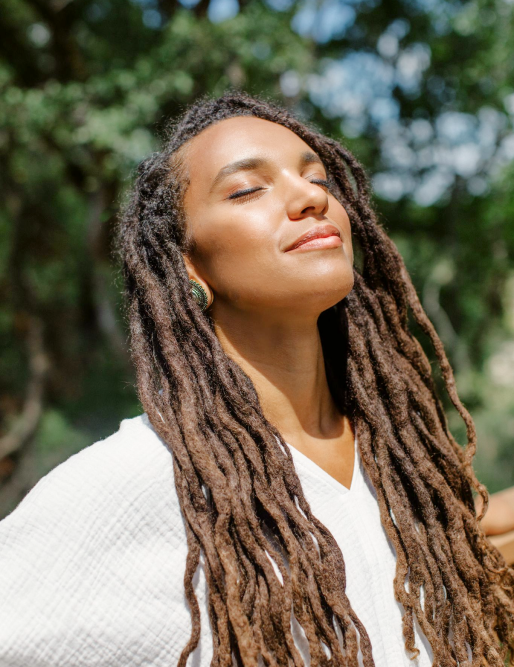What You Should Know About Vitamin D, Sunscreen & Healthy Sun Protection

For the past two decades, doctors have been telling us to lather up with sunscreen to protect our skin and prevent skin cancer.
In the past five years, however, studies are showing that we may need to forgo the sunscreen so we can get enough vitamin D - which is an essential nutrient in our body that many are deficient in.
Confused about what to do? Read on to learn more about when to apply sunscreen, when to forgo, and how to soak up the sun in a healthy way.
Facts About "The Sunshine Vitamin"
Vitamin D is essential to our health, and a vitamin many of us are lacking in.
It aids in bone, immune system, and muscle health, controls inflammation, helps maintain hormonal balance, modulates cells, and influences our genetics1 to name but a few of its important bodily functions.
New research has been done on the adverse health effects of Vitamin D deficiency, and studies have shown inadequate Vitamin D can cause osteoporosis in adults, weakened immunity, a higher risk of cardiovascular disease2 and greater susceptibility to certain types of cancers, and a higher risk of cardiovascular disease23.
As you’ve likely read about or experienced during your last physical, doctors have noticed a sharp increase in Vitamin D deficiency and now routinely test patients for Vitamin D levels, and studies are showing that the deficiency is related to our increase in sunscreen use4.
How Sunscreens Impede Vitamin D Absorption
We get Vitamin D two ways:
- Absorbing sun rays into our skin.
- Ingesting foods that contain the vitamin or that has the vitamin added to it (milk or cereal with added Vitamin D).
Getting D through the sun is the most effective and natural way of getting this essential vitamin. When we are out in the sun and can absorb the UVA/UVB rays, a chemical process occurs where our bodies synthesize the sun rays into Vitamin D5.
However, since the growing skin cancer awareness campaigns that began in the 1980’s, we have been unknowingly interfering in this natural process. When we apply sunscreen to block the UVA/UVB rays, we impede our bodies ability to synthesize those rays into Vitamin D, thus the increased cases of Vitamin D deficiency.
The Solution? High-Noon Full Sun Exposure
The updated thinking on sunscreen use and Vitamin D is that we need to spend at least some time out in the sun without sunscreen to get enough Vitamin D.
Studies suggest we spend at least 20-30 minutes outside at noon (when the sun is at its zenith and shooting the strongest rays of UVA/UVB rays) without sunscreen on to get the requisite amounts of Vitamin D.
When the sun is at its strongest, we will get the highest levels of UVA/UVB rays in the shortest amount of time. This gives us the optimal amount of sun exposure we need to create the vitamin in our bodies and the shortest amount of time we need to be fully exposed to the sun so we don’t increase our risks of getting skin cancer 6.
If you can’t (or don’t care to) make it out at high noon, check with your doctor about the right amount of sun exposure for your skin type and geographical location.
The Best Natural Sunscreens
Even though they do block Vitamin D absorption, sunscreens still have their place in keeping us healthy and preventing skin cancer.
However, most commercial sunscreens out there are just loaded with harmful, hormone-disrupting chemicals, which studies have shown can negate their protective benefits and actually cause certain types of cancer7.
Here are our picks for the best healthy, non-toxic sunscreens:
- Badger Balm Natural & Organic Mineral Sunscreen
- Luminance Skincare Sunscreen
- Babo Botanicals Clear Zinc Sunscreen Stick
- Blissoma Light Shifting Facial Sunscreen + Moisturizer
- Earth Mama Organics Sunscreen
- Kari Gran Sunscreen
- Juice Beauty Sunscreen
- Sun Love by Anne Marie Sunscreen
- Goddess Garden Organics Sport Sunscreen
Now, Get Outside!
To get your healthy daily dose of Vitamin D, go outside! Take the kids outside at noon and have lunch outside and let them soak in the rays and allow their bodies to naturally create Vitamin D.
Then put on chemical-free sun shirts 8 hats, sit under an umbrella, etc. to help minimize sunscreen use.
Use commonsense when applying sunscreen. If you’ll be outside all day or if you work outside all day, bring a bottle of non-toxic sunscreen and apply it after you have gotten your requisite amount of vitamin D.
Be healthy, be safe and have fun in the sun!
For more safe summer fun, check out How to Minimize the Chlorine Exposure At The Pool, and our Favorite Non-Toxic Sunscreens!
SOURCES:
-
https://www.medicalnewstoday.com/articles/318060.php
- https://www.ncbi.nlm.nih.gov/pmc/articles/PMC2851242/#:~:text=Cross%2Dsectional%20studies%20have%20reported,failure%2C%20and%20ischemic%20heart%20disease.
- https://www.health.harvard.edu/cancer/enough-vitamin-d-may-protect-against-some-cancers#:~:text=After%20adjusting%20for%20several%20known,with%20low%20vitamin%20D%20levels.
- https://www.sciencedaily.com/releases/2017/05/170501102258.htm
- https://ods.od.nih.gov/factsheets/VitaminD-health%20Professional/#h7
- https://www.ncbi.nlm.nih.gov/pubmed/18348449
- https://www.breastcancer.org/risk/factors/sunscreen
- https://youmemindbody.com/children/What-Chemicals-are-in-Rashguard-and-Swim-Shirts-to-Create-Sunblock
Categories

Marilee Nelson
Marilee Nelson is an Environmental Toxins expert who has spent nearly 30 years advocating for the chemically-sensitive and chronically-ill. She is a Board Certified Nutritionist, Certified Bau-Biologist and Bau-Biology Inspector and specializes in Food As Medicine. She has helped thousands of families and individuals identify, heal and recover from toxic exposures and is on a mission to revolutionize the way American families view their health.







